Tag: Tempranillo
Tempranillo, Part III
On the eve of our departure for WineMaker magazine’s annual conference, hosted in Monterrey, California, this year, I expressed some regret to the Vineyard Goddess that I didn’t have a bottle of home-made wine to take with me for one of the tasting events. I had bottled my Tempranillo some 35 days earlier, and while it was just past the bottle shock stage, I had not yet tasted it (and it was way too late to try it that night). For all I knew, it was plonk.
“Take it anyhow,” the VG told me. “Take two bottles. We can taste one on the first part of the trip, and if it’s good, you can take the other one to the tasting.”
Sage advice. I packed two, using my newly minted method of wrapping the bottles in bubble wrap (replacing my old method of wrapping them in t-shirts), and told myself we’d taste the first bottle when we arrived in Sedona on the first leg of our journey. As it turned out, I didn’t get to it until we reached the Grand Canyon for the second leg of the trip.
And what a surprise! It wasn’t the vintage of the century, but it was definitely good. I knew I had made some mistakes in the process, especially in the area of temperature control (overheating it at some points, and not keeping it warm enough at others), but it was still a good, solid drinkable wine. So, I felt confident that I could hold my own with the other winemakers, or at least not get ridden out of town on a rail.
The comments were generally favorable. The 100 or so winemakers who gathered for the tasting were seated at round tables of 10, and half the table rotated every ten minutes to be paired with new tasting partners. We tasted each other’s wine and provided feedback. I’d like to say that everyone was totally, if not brutally, honest, but I suspect we were more diplomatic than candid.
So, here are some of the comments:
“Young, but very hearty. As it ages, it will become a very nice wine.” (Oh, yeah, as it ages — someday it will be a decent wine!)
“Good tannins, good acidity, nicely balanced.”
“Good color, very dry. Nice tannins and structure.”
“Crisp acidity, not quite as much fruit as I’d like to see.”
Well, that’s as far as my notes go. Nobody was talking about long finishes or specific kinds of fruit on the nose or palate, but all in all, for a first outing, it wasn’t bad. As I said in a Facebook post, I had walked in with nightmares that my fellow tasters would spit my wine on the floor and then throw me out of the room. It was a relief to see that they all stayed and finished their taste of Bob’s Tempranillo.
Tempranillo, Part II: The Hydrometer Never Lies
I was pretty excited last Monday when I began making six gallons of Tempranillo wine. I thought I had been pretty clever in the way I had gotten the temperature just right before pitching the yeast, and I was pretty confident that things would go well.
And 24 hours after inoculating the unfermented must with yeast, I was pretty sure fermentation was well underway. The airlock was beginning to accumulate carbon dioxide, or CO2, bubbles and there was a fragrance in the air that I have always associated with fermentation. Also, there was a loud hissing sound inside the primary fermenter said there was something alive and growing inside. Yeast is a truly amazing microorganism.
Forty-eight hours in, I was beginning to worry. The airlock wasn’t bubbling up and down in the vigorous way I had expected, and I wondered if the fermentation had become stuck. Or worse, if it had actually been stillborn, and I had only been deluding myself the day before. I punched down the grape skins for a couple of minutes (the grape skins are pushed to the top of the fermentation vessel by the CO2 released during fermentation, and they must be “punched down” daily to ensure proper contact with the must – more on this in a later post) and then checked the temperature.
The results were a bit scary – almost 90 degrees. Apparently the heater I was using was a blunter tool than I had thought. That seemed a bit unjust. The last time I made wine, fermentation took forever, and was briefly stuck because I had let the house get too cold. Now, I had apparently gone too far in the other direction.
On Thursday, I was feeling even worse about the fermentation. I had shut down the heater, and the temperature had dropped to the low eighties.
Better for fermentation, but probably still a bit too hot to re-inoculate. I knew I could get the temperature down, but I wasn’t really sure how to go about reinoculating.
I had packages of two different kinds of yeast: RC212, which was the particular kind of yeast that came with the kit, and EC1118, a champagne yeast that is also supposed to be good for restarting stuck fermentations. I wasn’t sure which to use, whether I should rehydrate the yeast with some of the juice before pitching it, or whether I should get the temperature down first. So, I called the company’s technical support line.
I was using a Winexpert kit, and I can’t begin to say enough about their customer support. I got a real person on the phone in a couple of minutes, and she was terrific. Here’s how the conversation went (picking up after I explained the problem):
She: What was the specific gravity when you pitched the yeast?
Me: 1.082
She: What is it now?
Me: I haven’t checked, but since it doesn’t seem to be fermenting, I assume it’s still right around 1.08.
She: You need to check. Give me your number, and I’ll call you back in ten minutes while you take a reading.
Me: OK.
After about ten minutes, she called back.
Me: I just finished sanitizing the hydrometer and wine thief and I’m just filling the tube (for the hydrometer).
She: OK.
Me: Uh. . . Can this possibly be right? It looks like it’s 1.02.
She: You got it! It’s working.
Me: Uhhhh . . . yes, it is. (but thinking, yes, I am an idiot. . .)
What I learned from her was to rely on the hydrometer, not my visual checks. She was good enough to stay on the phone with me for another five minutes to talk about winemaking and to answer a few more questions about the kit. Honestly, it was one of the best customer support experiences I’ve ever had.
So, I let the wine continue fermenting. Twenty four hours later, the specific gravity was down to 1.011, and the night after that, it was just a hair over 1.000, maybe 1.001. Sunday morning, I’ll check again, and I think it will be time to rack it into a carboy for the secondary fermentation.
Meanwhile, I’m planning to start making a new batch of wine in a week or two, this time Winexpert’s Lodi Ranch 11 Cabernet Sauvignon. And I’ll be relying less on visual observations and more on things I can measure, like temperature, pH, and specific gravity.
After all, your eyes may deceive you, but the hydrometer never lies.
Making Tempranillo, Part I
So much of what I’ve written on Project Sunlight has to do with the vineyard – planting vines and tending them until they’re ready for that first harvest. Well, okay, we’re actually a long ways from that first harvest, so in fact most of what I’ve written has to do with that first year in the vineyard, from preparing the ground to planting and caring for the vines over the course of that year. Someday soon, I hope to write the next chapter, the one that has to do with turning simple grapes into something noble. But we have at least another two years before we take that step and make wine from our grapes.
And yet, I want to make wine – now. So, what to do? I am very hopeful that next fall I’ll be able to buy fresh fruit from somebody else’s vineyard, and make wine from those grapes. But that’s a long ways away, and I’m feeling a need to get some experience with the whole process of fermentation before I start playing with freshly harvested grapes. It’s also possible I’ll be able to buy some grapes shipped in from Chile in the next month or so (the southern hemisphere runs opposite to our world – our fall is their spring, and their spring is our fall), but I’m not sure about that.
Wine kits, though, offer a world of possibilities – literally. You can get kits that contains juice and crushed grapes from Argentina’s Mendoza region or South Africa’s Western Cape. You can buy Chilean Cabernet Sauvignon or Australian Shiraz or Oregon Pinot Noir, for that matter, and make those wines at home whenever you want.
Years ago, I turned my nose up at the idea of making wine from a kit. But from what I’ve read over the past few years, kits have gotten better and better. Two years ago, after receiving a starter set with all the equipment from my daughter as a Christmas gift, I tried my hand at one. I made so many mistakes that I should have been grateful to have ended up with decent vinegar. But I worked hard at it, and when I was finished I decided that the very least I could say about it is that it was honest to God wine.
I wondered if that would be the most I would ever be able to say about it as well, and I suppose the answer is somewhere in the middle. It wasn’t great wine, but my kids liked it well enough to ask me to bring a couple of bottles with me when I traveled out to visit (in California, no less), so it at least found an audience. And every time I open a bottle, I tell myself, “Hey – this ain’t so bad.” And yes, I know – that’s a pretty low hurdle.
In any event, I decided to try my hand at it again. This time, I’m making a Spanish Tempranillo, one of my favorite varietals. The kit was made by Winexpert, and it came with a bladder of juice, a smaller bladder of crushed grapes, and of course all of the yeast, fining agents and the like that one needs to turn the juice into wine. Continue Reading–>

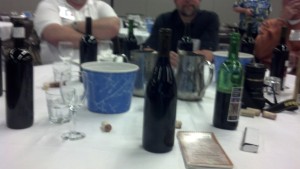
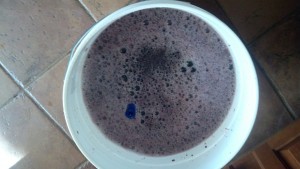
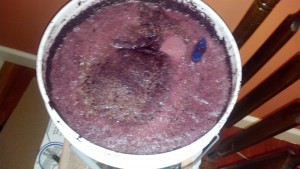
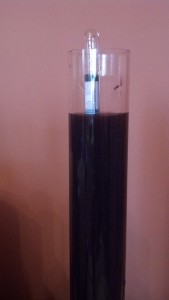
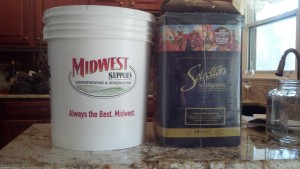


Recent Comments